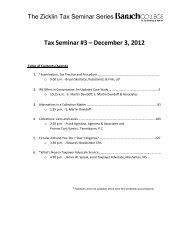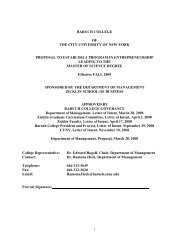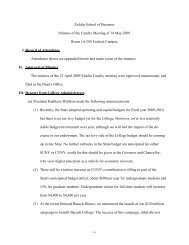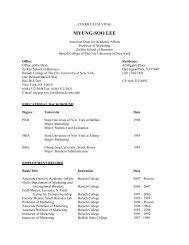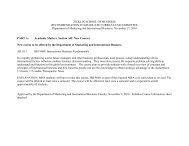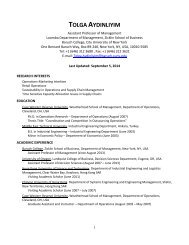Current Financial Reporting Trends
Current Financial Reporting Trends: - Zicklin School of Business
Current Financial Reporting Trends: - Zicklin School of Business
- No tags were found...
Create successful ePaper yourself
Turn your PDF publications into a flip-book with our unique Google optimized e-Paper software.
accounted for as discontinued operations was because of the registrant’s continuing involvement<br />
with those properties as outlined in EITF 03-13, please clarify that to us and expand your<br />
accounting policy in future filings to clarify this. Please note that each property disposition typically<br />
represents a component of the business and as such is accounted for as discontinued operations<br />
under SFAS 144.<br />
Comment #435 – Form 10-K; SIC: 5812 Retail-Eating Places<br />
We note this category includes gains (losses) from disposal or write-off of property. In accordance<br />
with the guidance in paragraph 45 of SFAS 144 as well as footnote 68 in Staff Accounting Bulletin<br />
No. 104 (Topic 13), you should classify gains (losses) from the sale of assets within operating<br />
income (loss) in the consolidated statements of operations. Please revise accordingly in future<br />
filings.<br />
Comment #202 – Form 10-K; SIC: 7900 Services-Amusement & Recreation Services<br />
Reference is made to your classification of "gain on sale of land, buildings and equipment" as other<br />
income. In accordance with the guidance in paragraph 45 of SFAS No. 144 as well as footnote 68<br />
in Staff Accounting Bulletin No. 104 (Topic 13), you should classify gains (as well as losses) from<br />
the sale of assets within "Operating Income" in your consolidated statements of earnings. Please<br />
revise accordingly in future filings.<br />
Comment #409 – Form 10-K; SIC: 3600 Electronic & Other Electrical Equipment (No<br />
Computer Equip)<br />
We note your critical accounting policy regarding long-lived assets, which states that "for those<br />
businesses monitored by management for impairment, their fair value would have to be lower by<br />
more than 20 percent before an impairment charge would be recognized." Please describe the<br />
businesses and other assets that are monitored in this manner and tell us why it is appropriate to<br />
recognize an impairment charge only when the 20 percent threshold is exceeded. Refer to SFAS<br />
144 in your response.<br />
The previous comment was resolved with the following response:<br />
Response to Comment #409 – Form 10-K; SIC: 3600 Electronic & Other Electrical Equipment<br />
(No Computer Equip)<br />
The objective was to provide a qualitative and quantitative discussion about impairment of longlived<br />
assets, particularly goodwill. We were not implying that there is no impairment unless fair<br />
value decreases by greater than 20 percent below carrying value. None of the Company’s<br />
businesses or other assets is evaluated in that manner. Our intention was to convey that the<br />
estimates of fair value for these businesses would have to be lower by more than 20 percent<br />
before their carrying value would exceed their fair value. As disclosed on pages 27 and 34 of the<br />
Annual Report (Exhibit 13), the Company’s policy is to record an impairment for the amount by<br />
which the carrying value of a long-lived asset exceeds its fair value in accordance with FAS 142 for<br />
goodwill and FAS 144 for other long-lived assets. We will ensure that this disclosure is clear in<br />
future filings.<br />
Stock Option Accounting<br />
The two examples provided for this topic refer to SFAS No. 123 or SFAS 123(R). Responses that<br />
resolved the comments are also given.<br />
Comment #520 – Form 10-K; SIC: 3760 Guided Missiles & Space Vehicles & Parts<br />
Please clarify your policy for recognizing compensation expense on the issuance of performance<br />
units. We note that you currently recognize the expense as the performance criteria are met. Tell<br />
us if you consider the probability of the performance condition being met and recognize<br />
compensation expense accordingly. Please refer to the guidance in SFAS 123 and SFAS 123R<br />
and advise.<br />
20



